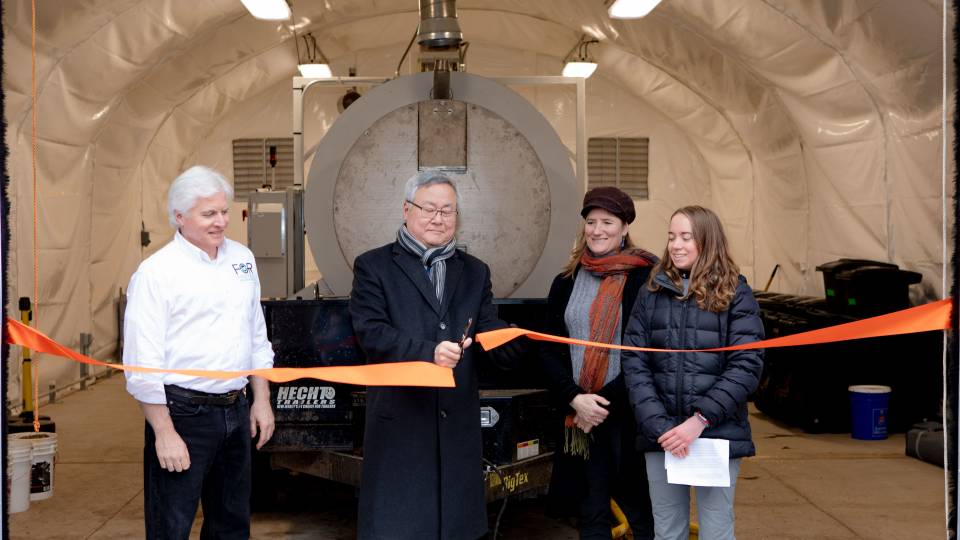In 2012, the University completed a restoration of meandering and stepped form for a portion of the stream along Washington Road to mitigate erosion and flood risks and improve the riparian habitat.
Research projects that explore energy-saving technologies, sustainable farming and resource reuse have been selected to receive Dean for Research Innovation Funds for the Campus as a Lab.
The five projects will be conducted with the University’s grounds as the laboratory or testbed for the exploration of technologies or practices that enhance sustainability and environmental responsibility. The campus serves as a real-world setting where ideas and theories can be tried on a relatively small scale, with the goal of scaling up successful projects beyond campus.
Princeton aims to engage the entire University community in creating a more sustainable campus and world through its new Sustainability Action Plan, announced on Earth Day, April 22. The campus as a lab projects are one aspect of this broad endeavor.
A faculty-led committee chose the winning proposals based on quality, originality and potential impact on the campus or in the field of study. All projects involve either graduate students or postdoctoral researchers, or undergraduate students.
Funding for the Dean for Research Innovation Funds for the Campus as a Lab comes from the Princeton Environmental Institute, Office of the Dean for Research, Andlinger Center for Energy and the Environment, High Meadows Foundation Sustainability Fund, and Facilities. The funding program is administered by the Office of the Dean for Research in collaboration with the Office of Sustainability.
Selected projects involving graduate students or postdoctoral researchers:
Adding renewables to the electrical grid

Minjie Chen and Darren Hammell
To meet the challenge of including renewable energy sources such as wind and solar to the electrical grid — the network of power stations and lines that deliver electricity to homes and businesses — a team of researchers will build a prototype grid to allow experimentation on ways to coordinate electricity from renewable and non-renewable sources. Solar and wind energy production fluctuates widely depending on weather and time of day. An electric grid with a large percentage of renewable integration may become highly unstable if not coordinated correctly.
The research team, led by Minjie Chen, assistant professor of electrical engineering and the Andlinger Center for Energy and the Environment, and Darren Hammell, the Gerhard R. Andlinger Visiting Fellow in Energy and the Environment, will test ways to incorporate solar, wind, battery and other sources of power by building a testing environment called the Andlinger Distributed Energy and Power Testbed (ADEPT). The testbed will be highly programmable to allow the team to explore various configurations of power supplies as well as spikes in power usage, such as the greater demand posed from charging electric vehicles. The project will also explore innovations in how to meet spikes in user demand, such as programming the grid to autonomously cluster into “micro-grids” to defend against cyberattacks or natural hazards, and using smart technologies to enhance grid stability.
Building without waste

Erin Besler and Stefana Parascho
Reducing and reusing leftover construction materials — typically scraps of metal, wood and concrete —is the focus of a new initiative to improve the ecological footprint of architecture. The project, led by Erin Besler and Stefana Parascho, two assistant professors in the School of Architecture, has two parts: new design tools to cut down the ordering of excess materials and innovative robotic assembly methods to reuse existing materials.
To reduce construction leftovers, the team will build an intuitive-to-use design tool that improves architectural planning. For existing leftovers, which often come in irregular shapes that can be a challenge to reuse, a team made up of faculty, graduate students and Facilities staff members will use computational approaches and robotics to design structures incorporating the materials. The project offers a way for architects, contractors and builders to develop more sustainable approaches to planning and constructing buildings. For the broader public, the project offers the opportunity to experience cast-off materials in architectural designs and structures.
Selected projects involving undergraduate research:
Field-testing solar-powered smart windows

Yueh-Lin (Lynn) Loo
A new smart-window technology that uses solar power to darken or lighten window glass — which saves energy by reducing the need for heating and cooling indoor spaces — will be tested this summer on buildings around campus. The technology involves coating windows with a film of flexible, transparent solar cells that convert sunlight into electrical energy to drive the change in transparency. Developed in the laboratory of Lynn Loo, director of the Andlinger Center for Energy and the Environment and the Theodora D. '78 and William H. Walton III '74 Professor in Engineering, these organic photovoltaic cells could power smart windows without the need for an external electrical power supply, allowing this technology to address retrofits and upgrades of existing windows.
To determine how these solar-powered smart windows perform in real-world situations, undergraduate Matthew Marquardt, Class of 2021, will install and evaluate them in campus buildings. In collaboration with engineers at Andluca Technologies, a startup founded by members of the Loo group, Marquardt will design hardware to monitor and control the solar cells via the internet of things, integrate the solar cells with smart windows, and develop software to optimize the energy savings and benefit to occupants.
Building better compost

Xinning Zhang
A team of researchers will work with Princeton’s on-campus composting facility to explore conditions for creating high-quality compost that is high in nutrients and low in greenhouse gas emissions. The facility, known as the Sustainable Composting Research at Princeton (S.C.R.A.P.) Lab, houses a biodigester that converts campus food scraps into nutrient-rich plant food, helping to divert food waste from landfills and reduce reliance on chemical fertilizers. The biodigester consists of a large barrel that rotates to mix air with food waste and a carbon source — such as wood chips or cardboard — to aerobically decompose the materials into compost in just five days.
The team, which will include an undergraduate researcher and be led by Xinning Zhang, assistant professor of geosciences and the Princeton Environmental Institute, will test various proportions of food waste, carbon inputs and air as well as operating conditions to identify conditions that create compost with superior levels of nutrients while reducing the natural emission of greenhouse gases due to biodegradation of compostable materials. The team will also explore the use of waste cardboard from the campus to replace wood chips.
Farming on campus lands

Daniel Rubenstein and Gina Talt
A new study will explore how to improve Princeton's land stewardship practices in ways that encourage sustainability while improving agricultural yield. Princeton University enables local farmers to raise crops on large portions of its land, but in recent years farmers have reported finding it hard to make a profit due to crop consumption by deer. Additionally, years of growing monoculture crops with herbicides and fertilizers have led to nutrient-deficient soils and a system reliant on fossil-fuel-based inputs to suppress weeds.
The project — led by Daniel Rubenstein, the Class of 1877 Professor of Zoology, a professor in the Department of Ecology and Evolutionary Biology, and director of the Princeton Environmental Institute’s certificate Program in Environmental Studies, along with Gina Talt, food systems project specialist with the Office of Sustainability — will involve undergraduates in examining the cost-effectiveness of fencing the lands to keep out deer while also exploring a variety of soil enriching and anti-weed control methods. The team will grow field corn in one-acre test plots, including fenced and non-fenced areas, to compare how farming practices affect crop growth, soil health and farmland profitability. The sustainable practices to be tested include applying compost made from campus food scraps, planting cover crops during the off-season, and weeding with equipment rather than applying herbicides.






